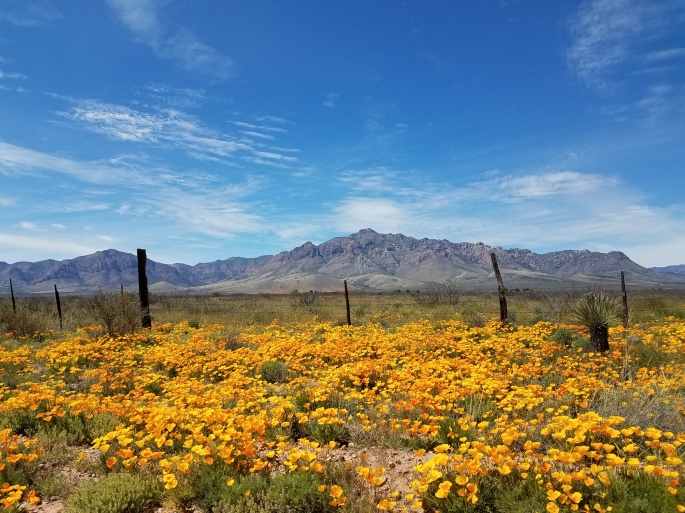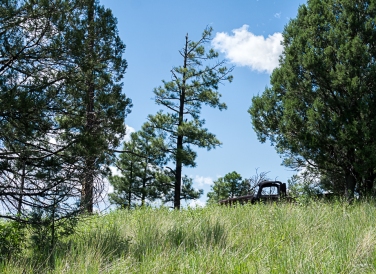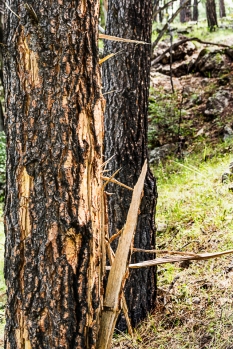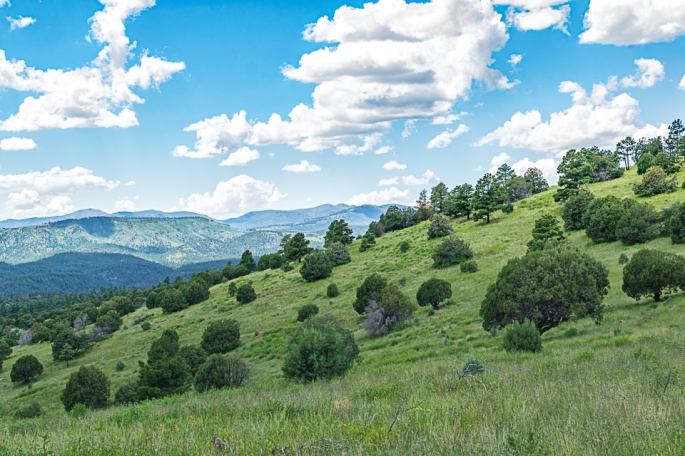 My friend, Dog and I go up to Cherry Creek trail early this morning while it is still cool. This Gila National Forest trail is one of my favorites, especially in warm weather because it drops down from the road, following a creek through a canyon. It may be 75° at 6,000 feet (where my house is) at 8 am; there in the canyon it is 55° and green.
My friend, Dog and I go up to Cherry Creek trail early this morning while it is still cool. This Gila National Forest trail is one of my favorites, especially in warm weather because it drops down from the road, following a creek through a canyon. It may be 75° at 6,000 feet (where my house is) at 8 am; there in the canyon it is 55° and green.
Today, we take binoculars because there are several species of spring arrivals that we hope to see; that is, if Dog will be patient enough to let me put binocs to eyes and focus on the branches overhead.
The meadow, woods and riparian stretches are great attractors for warblers, wrens, vireos, and more. The challenge, of course, is that the trees are leafing out, giving those little guys lots of opportunities to flit from behind one leaf to behind the next, with a duck behind a tree trunk along the way. This is social distancing at its most frustrating.
One constant on this trail, at least at this time of year, is the sound of running water. There are numerous crossings of Cherry Creek to be made, hopping from rock to rock and hoping that Dog, always leashed, doesn’t get too exuberant and pull me into the water.
Friend and I make poor time as hikes go, but great time for birding. Neither of us are particularly good at identifying by song and not a whole lot better identifying what we see. Still, there are a few spring celebrants who are impossible to mistake, assuming we can find them high above.
Those lovelies that we see and recognize today include Red Faced Warbler, Painted Redstart, House Wrens, Robins, Juncos, Stellar Jay, Vireo, Acorn Woodpecker, Swifts and an unidentified hawk. If those warblers weren’t so good at staying socially distant, despite my noisy efforts to pish them down, we might see more.
Butterflies are also warming to spring. A variety of whites, blues, sulphurs and brightly-marked butterflies flutter from flower to leaf to blooming grasses. Those I recognize are Sara Orangetip, Queen Alexandra’s Sulphur and Swallowtails. I think I notice a Mourning Cloak – or is that an Arizona Sister? Such engaging names we give these creatures.
Hard to take pictures of those fast-moving, darting beings. I am reduced to beings that don’t move much except as the breeze stirs them. A wild clematis in bloom – I’ve never seen one before. Various yellow wildflowers, aka dyc or damn yellow composite–they are the equivalent of an LBJ to a birder—fill the sunny spots. And there’s my hugging tree—a gnarled old grandmother cottonwood. Since we can’t hug our two-legged friends these days, a hug of that old cottonwood gives back a grounded energy.
Depending upon your frame of reference, the damper to the day or the interesting and unexpected find is a mule deer that had been taken by a predator, partially eaten and left right on the side of the campground entrance where we are parked and only 20 feet or so off the main road. Since I’m used to finding evidence of our four-legged neighbors that is far less graphic, I can’t resist taking some pictures and posting them to my tracking group to see if anyone has a clue whether this deer was taken by a mountain lion or coyotes. My guess is mountain lion. As I said, it all depends on your frame of reference.
I’ll be leading a hike along Cherry Creek for our lifelong learning organization in July. By then, the birds will be quieter, having found mates and being busy raising peeps. By then, the water will probably be found only in residual pools. By then, a whole new succession of dyc’s will be in bloom. But it will still be cool. And green. And old grandmother cottonwood will still be giving and receiving hugs in a time of human social distancing.







 Poppies. Mexican Poppies glowing along the roadside, in painterly splashes on the hillsides. And most spectacularly, spread across fields as quilts made of yellow, orange and gold, with love-knots of white. In New England, they go leaf-peeping in the fall. This week, I have indulged in Poppy-peeping.
Poppies. Mexican Poppies glowing along the roadside, in painterly splashes on the hillsides. And most spectacularly, spread across fields as quilts made of yellow, orange and gold, with love-knots of white. In New England, they go leaf-peeping in the fall. This week, I have indulged in Poppy-peeping.





 Wilderness isn’t empty, not of people and not of things. To the right of the trail, silhouetted against the sky is a relic: a 40’s era truck driven out to the edge of the world and abandoned, fodder for curious hikers’ wonder and speculation.
Wilderness isn’t empty, not of people and not of things. To the right of the trail, silhouetted against the sky is a relic: a 40’s era truck driven out to the edge of the world and abandoned, fodder for curious hikers’ wonder and speculation. There’s an overlook where we see our destination, a river-side meadow specked with the white kitchen tent secluded under a clutch of pines. The scary aspect of the view is that we have to get down there. As we pick our way among the trail rubble, we hear the mules coming with our weight of tents and bags. The outfitter calls down to us, “Move to the downhill side. Mules spook if a critter is above them. Is that you behind a bush? Move out where the mules can see you.” I step down and out of the way, and watch the outfit step on by us, more surefooted than I am, for sure. Then, we work our way on down to level ground, off the sun-exposed cliff-side and into the shade.
There’s an overlook where we see our destination, a river-side meadow specked with the white kitchen tent secluded under a clutch of pines. The scary aspect of the view is that we have to get down there. As we pick our way among the trail rubble, we hear the mules coming with our weight of tents and bags. The outfitter calls down to us, “Move to the downhill side. Mules spook if a critter is above them. Is that you behind a bush? Move out where the mules can see you.” I step down and out of the way, and watch the outfit step on by us, more surefooted than I am, for sure. Then, we work our way on down to level ground, off the sun-exposed cliff-side and into the shade.








